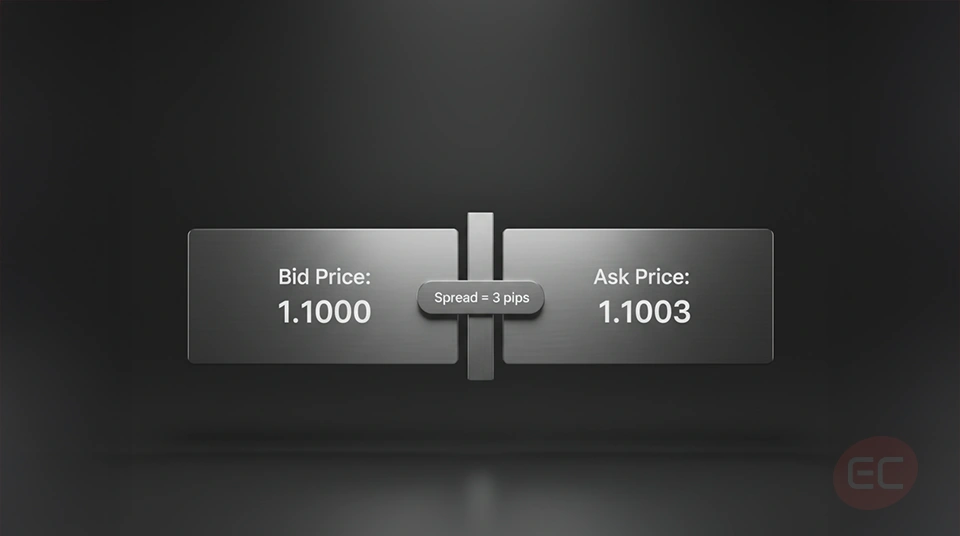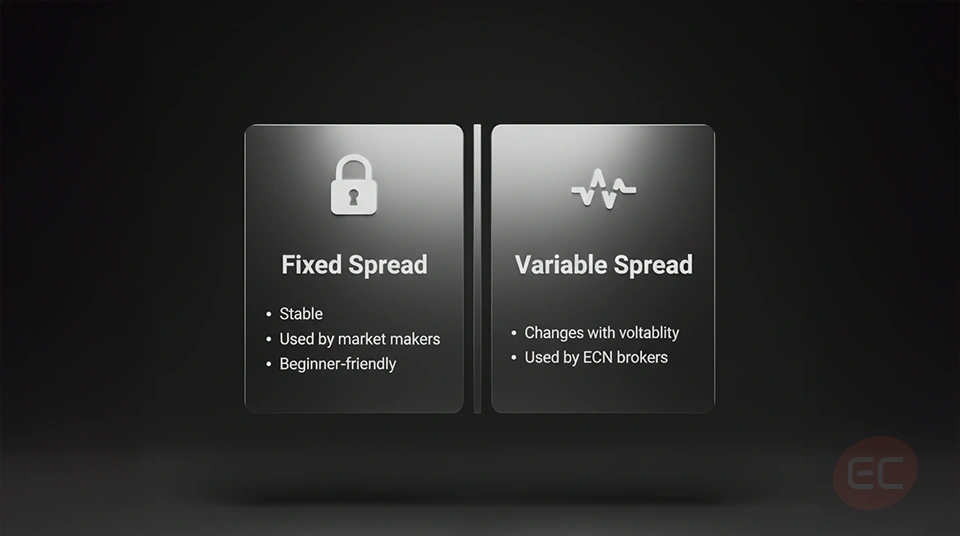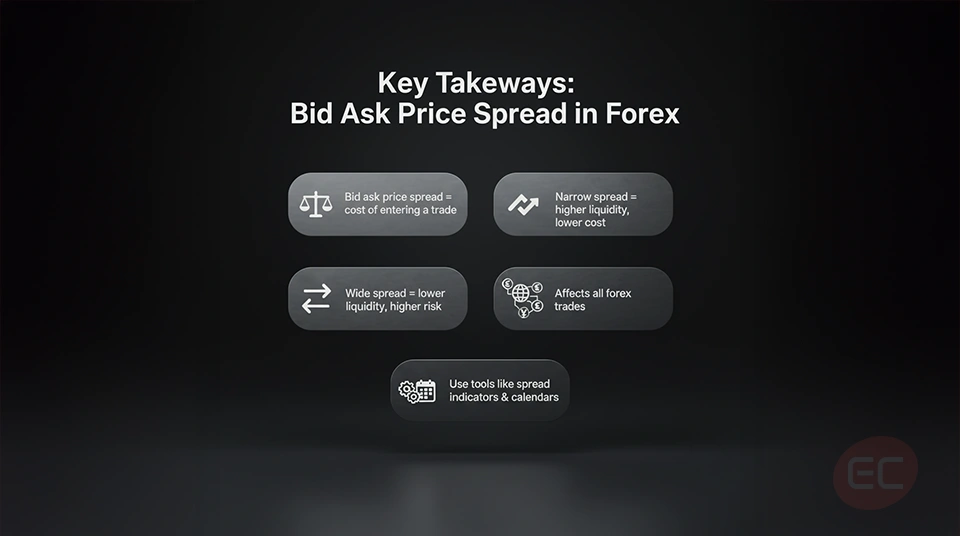What Is Spread in Forex: Understanding the Bid Ask Price Spread

Within the Forex space, there are a number of terms that can be confusing for beginners, with common questions like 'what is bid ask price spread?' and 'what is spread in forex?'. Forex spread plays a crucial role in every single trade you make, so understanding these terminologies is imperative to becoming a confident trader. In this course, we are going to break down some key terminology that every trader should know including the meaning of spread in forex and the Bid Ask Spread explained in simple terms. Let's get started!
- Bid Ask Spread Explained
- Bid Ask Price Spread Examples
- Bid Ask Price Spread: What is Spread in Forex Trading?
- What factors affect Bid Ask Price Spread?
- Ask Price - Bid Price = Spread
- Why does the Bid Ask Price Spread matter so much to Forex Traders?
- Here are some Key Reasons why the Bid Ask Spread matters as much as it does:
- Here are a few tools you can use to monitor the bid ask price spread:
- Why understanding the meaning of Spread in Forex is crucial to Traders:
- Conclusion: What Is Spread in Forex - Understanding the Bid Ask Price Spread
Bid Ask Spread Explained
Knowing what is spread in forex means we must have the bid ask spread explained and clearly understood in our minds.
At the very core, the bid ask price spread is the difference between the price a buyer is prepared to pay for a currency (the bid) and the price a seller is asking for (the ask). It’s the absolute fundamental concept of forex trading and the main principle to understanding forex and making informed trading decisions. Don’t worry, we will break it down even more to ensure you’re absolutely comfortable with the term.
Bid Ask Price Spread Examples
Let’s get the bid ask spread explained using some key examples to help you understand the meaning of spread in forex.
Assuming you would want to exchange USD for EUR as per the below:
- Bid Price: 1.1000
- Ask Price: 1.1003
The bid ask price spread is the difference between: 1.1003 - 1.1000 = 0.0003 or 3 pips.
The 3 pip bid ask price spread is known as the transaction cost - this is the bid ask spread explained in its most basic form. But why is it so important? The bid ask price spread is crucial to trading for a couple reasons. The first and possibly most important is the cost of trading. The spread in forex is actually the cost you are paying to open a trade. Market liquidity is another crucial factor as the tighter bid ask price spread usually indicates a more liquid market. Lastly, the bid ask price spread also acts as a volatility indicator. A widening bid ask price spread is often a signal to increased market volatility. The narrower the ask bid spread, the better it is for traders usually. That is the bid ask spread explained simply. Let's now break down the types of spread!
Bid Ask Price Spread: What is Spread in Forex Trading?
You might be wondering what is spread in forex, don’t worry, you’re not alone. Let’s dive into it!
Essentially, the meaning of spread in forex is simply the core cost of trading. So when you’re buying a currency, you’re doing so at the ask price, and when you’re selling a currency, you’re doing so at the bid price. In other words, you’re always buying slightly high and selling slightly low, that’s where the bid ask price spread affects your profitability.
There are different types of spreads in forex, two main ones to be exact: fixed spreads, and variable spreads. Here are some of their main characteristics:
1) Fixed Spread
- It usually remains constant regardless of the market conditions.
- It’s common with market maker brokers.
- It’s easier for beginner traders to manage.
2) Variable Spread
- It usually changes based on market volatility.
- It’s common with ECN brokers.
- It can be tighter during stable periods but wider during news events.
No matter the type of spread, the bid ask price spread is always present throughout and it’s crucial to keep an eye on it at all times.

What factors affect Bid Ask Price Spread?
Now that we have bid ask spread explained, what are factors that can have an affect on the bid ask price spread in the forex spread market? Let’s explore the main ones:
- Market liquidity: high market liquidity usually means a narrower ask bid spread.
- Time of the day: spreads tend to widen during off market hours or specific holidays.
- Economic news releases: news events often cause spreads to spike due to market volatility.
- Currency pair: Major pairs, including EUR/USD for example tend to have a tighter bid ask price spreads than exotic pairs.
Let’s find out how you can calculate the bid ask price spread. To calculate the bid ask price spread is straightforward, here’s how it works:
Ask Price - Bid Price = Spread
For example:
- Ask: 1.3450
- Bid: 1.3447
- Spread: 0.0003 or 3 pips
Here’s an important tip to keep in mind! Use the ask bid spread in forex as a part of your trading plan, so you can keep track of when forex spreads are tighter. Tighter forex spreads can typically help you save on costs.
Why does the Bid Ask Price Spread matter so much to Forex Traders?
The bid ask price spread may seem like a more minor detail, but the reality is that it plays a critical role in your trading journey. Having the bid ask spread explained early in your forex journey helps you avoid confusion when analysing price charts and placing trades. Every single time you open a trade, you’ll notice that it actually starts off at a small loss, this loss is in fact the forex spread. The forex spread is the difference between buying and selling prices (ask vs bid). Over a period of time, especially for people who trade frequently, these costs can significantly add up. So why is this as important as it is? Because, for you as the trader, the meaning of spread in forex is the price you’re paying in order to get access to the financial market. A wider bid ask price spread indicates higher transaction costs, and a narrow one indicates more efficient trading opportunities. The bid ask price spread also works as a very useful tool that indicates market liquidity and volatility. Tighter ask bid spreads usually occur in higher liquid markets, on the contrary, wider ask bid spreads can actually suggest lower liquidity and or even higher risks.
Here are some Key Reasons why the Bid Ask Spread matters as much as it does:
1) First and probably the most important, the bid ask spread determines your cost of entry. What does that mean? It means that from the moment you place a trade, you’re actually paying the bid ask price spread. The easiest way to look at it is imagining that it’s an invisible transaction fee that builds into the price you see on your trading platform. A common mistake that a lot of new traders make is to overlook this fee, but it’s the ask bid spread that can actually make the difference between a profitable trade and a loss, so understanding the bid ask spread is crucial to your trading success.
2) It’s a reflection of real time market conditions. The bid ask price spread is actually one of the best indicators of market sentiment and liquidity. When the market is more calm, liquid and moving at a steady page, the ask bid spread is usually on the narrow side. On the opposite end though, when the market is experiencing high volatility, during major news announcements for example, the ask bid spread widens. Understanding the power of what is spread in forex, especially in relation to market volatility is an important role in executing well timed trades.
3) Last but not least, it can have a major impact on your trading strategy. Your trading approach should take into consideration the spread in forex. Why? Here’s an example: let’s say you’re a day trader or a scalper, you would want to trade currency pairs that offer a tighter bid ask price spread so you’re not losing profits in case of high transaction costs. On the other hand though, swing traders would probably want to absorb a larger spread if their profit targets are wider.
Here are a few tools you can use to monitor the bid ask price spread:
More modern platforms can provide several tools to help you monitor the bid ask price spread in real time. By using these tools efficiently, you can get a real key edge! Here are a few crucial tools every trader needs to know about:
1) Spread indicators: they display the current spread in forex directly on your chart, giving you instant feedback on the bid ask price spread fluctuations.
2) Economic calendars: these should be used to anticipate times that the forex spread might be more wide. Understanding what is spread in forex and anticipating it in advance can help avoid any unnecessary losses.
Why understanding the meaning of Spread in Forex is crucial to Traders:
We’ve covered a lot of technical data, but let’s zoom out for a second. For all traders, whether you’re a beginner or slightly more advanced, understanding the meaning of spread in forex can be one of the most useful concepts in trading. So when someone asks, ‘what is spread in forex’ , the simple answer is: it’s the cost a trader pays to simply enter the market, and the more you open a trade, the more the bid ask price spread can affect your performance. Experienced traders who really understand the concept of how spread in forex works can enter trades at more accurate times, choose smarter instruments and avoid unnecessary costs.
Conclusion: What Is Spread in Forex - Understanding the Bid Ask Price Spread
If you’ve made it this far into the course and having read through the Bid Ask Spread Explained, you should now have a good understanding of the meaning of spread in forex, so here is a summary of everything we’ve covered so far:

- The bid ask price spread is the difference between the buying and selling price of a specific currency. It’s a representation of your trading cost and it can dramatically fluctuate based on market conditions, liquidity and even the time of day.
- There are two types of forex spread: fixed and variable. Various factors, including economic news can have a direct influence on the ask bid spread.
- Traders can use tools like spread indicators and economic calendars to help manage and monitor the spread in forex correctly.
- Understanding the meaning of spread in forex can drastically help traders reduce cost, plan ahead of time their trades, and improve potential profits.
We hope you enjoyed our course on 'What Is Spread in Forex?'. By now, you should have an understanding of the meaning of spread in forex and what is meant by the bid ask price spread. If you want to deepen your trading knowledge and explore more concepts like forex spread, then keep reading the EC Markets Academy courses as we explore more crucial trading topics.